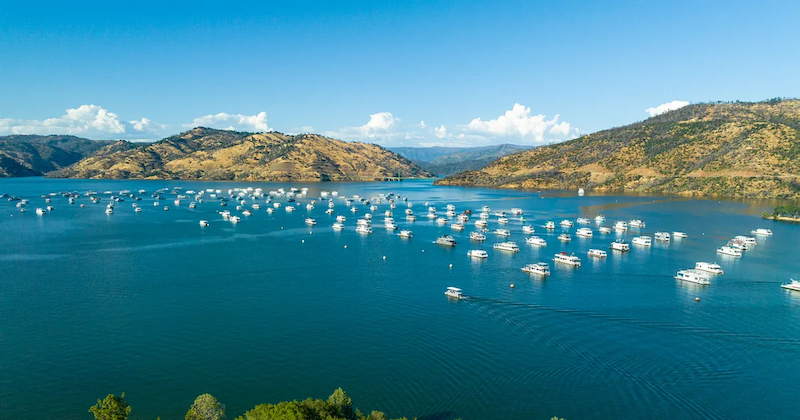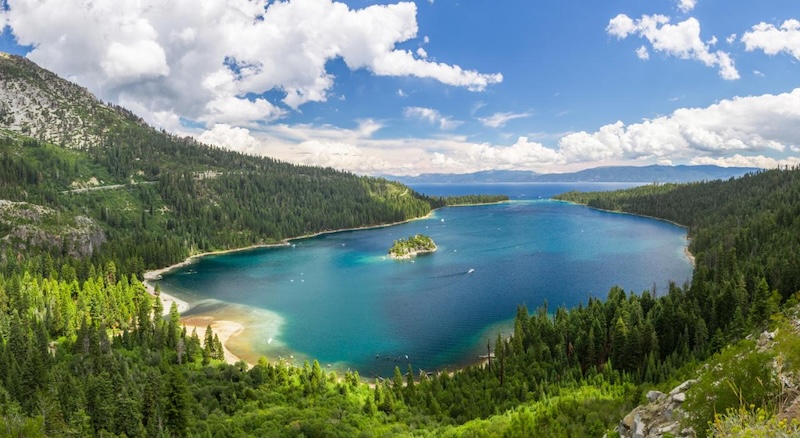
Lake Tahoe: a mindful explorer's guide to swimming, hiking and kayaking
The first time I stood at Lake Tahoe's edge, the clarity of the water stopped me in my tracks. You can actually see 70 feet down on a calm day, smooth stones shifting from cobalt blue to turquoise as they slope toward depths that hold centuries of Sierra snowmelt. That's the magic of Tahoe – it pulls you in and slows you down, asking you to notice what's right in front of you.
We created this guide for fellow travelers who seek more than just vacation snapshots. Whether you're planning to swim in crystal-clear coves, hike trails that deliver panoramic lake views, or paddle into quiet morning waters, Lake Tahoe rewards those who explore with intention and care.
Key takeaways about Lake Tahoe
Lake Tahoe offers crystal-clear waters with visibility reaching 70 feet deep, creating magical swimming, kayaking, and paddleboarding experiences in spots like Sand Harbor, Emerald Bay, and Secret Cove.
-
The lake straddles California and Nevada with the western shore showcasing natural wonders like Emerald Bay, while the eastern Nevada side balances outdoor adventures with small town charm around Incline Village and Crystal Bay.
-
Each season transforms Lake Tahoe uniquely – spring brings waterfalls and wildflowers, summer offers perfect swimming conditions, fall paints the landscape with golden aspens, and winter creates a snow-globe world of white-dusted shores.
Exploring Lake Tahoe mindfully through Leave No Trace practices helps preserve its remarkable clarity and beauty for future generations while deepening your own connection to this extraordinary alpine wonder.
Where is Lake Tahoe?
Lake Tahoe sits cradled in the Sierra Nevada mountains, a natural wonder that spans across both California and Nevada. Let's get you oriented to this remarkable lake that draws mindful travelers year after year.
Getting your bearings
Lake Tahoe reigns as North America's largest alpine lake, famous for its startlingly clear waters and mountain-ringed shores. The lake stretches roughly 22 miles long and 12 miles wide, with a 72-mile shoreline tracing its edges. Perched at 6,225 feet above sea level, this high-elevation haven offers completely different experiences as seasons shift.
The lake naturally divides into two distinct areas: North Lake Tahoe and South Lake Tahoe. The north shore tends to feel more relaxed and intimate, with communities like Truckee, Incline Village, and Crystal Bay offering quiet coves alongside small-town warmth. Head south and you'll find a livelier atmosphere with casinos, nightlife, and a wider range of dining spots concentrated along the shore.
Straddling California and Nevada
What makes Lake Tahoe particularly special is how it bridges two states. The border cuts right through the water, with California claiming the western shore and Nevada the eastern edge.
The California side showcases some of the lake's most photographed natural features, including Emerald Bay and Sand Harbor - perfect spots for wild swimming, hiking, and soaking in the majestic Sierra Nevada landscapes. Cross to the Nevada side around Incline Village and Crystal Bay, and you'll find a blend of outdoor adventures alongside casino entertainment options.
This unique cross-state position means your Lake Tahoe experience can be entirely what you make it - from silent forest trails to paddle-perfect coves, all within the same remarkable basin. The lake welcomes explorers of every kind, whether you seek quiet reflection or active discovery.
Why Lake Tahoe calls to mindful explorers

Lake Tahoe's allure goes beyond postcard views; it speaks to something deeper in those who seek meaningful connection with wild places. We've found that what draws thoughtful travelers here isn't just the scenery (though it's undeniably stunning) — it's the way this place invites you to slow down and notice the small miracles happening all around you.
That legendary crystal-clear water
The clarity of Lake Tahoe's water isn't just beautiful — it's almost mystical. On calm mornings, gazing down from a dock or kayak, you'll see rocks and sand 30 feet below as clearly as if they were just beneath the surface. This remarkable transparency isn't an accident; it's the result of a watershed that naturally filters the snowmelt and rain before it reaches the lake.
Scientists measure this clarity yearly, dropping a white disk into the water until it disappears from view. In good years, that disk remains visible down to depths of 70+ feet. For perspective, that's like being able to clearly see a car parked over seven stories below you.
The most magical way to experience this clarity? Float quietly on a paddleboard at Sand Harbor or Baldwin Beach, watching your shadow drift across the lake bottom. The water here doesn't just look clean — it feels clean too, cool and refreshing against your skin when you finally gather the courage to jump in.
Where mountains meet tranquil shores
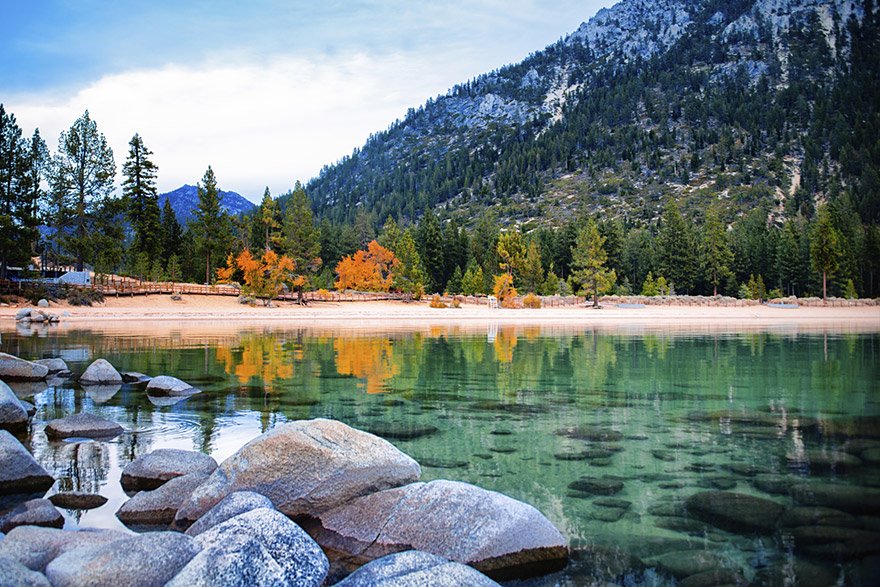
The Sierra Nevada mountains don't just surround Lake Tahoe — they cradle it. These granite peaks, some still snow-capped well into summer, create a natural amphitheater that changes with the light throughout the day. At sunrise, the first golden rays catch the western ridgelines; at sunset, the entire basin glows with alpenglow.
Hiking here means constantly toggling between forest shade and sudden, breathtaking vistas. The Tahoe Rim Trail offers some of the most rewarding views, with sections like the climb from Echo Lakes revealing the vast blue expanse of Tahoe stretching north to the horizon. Even short walks like the Rubicon Trail along the southwest shore put you right at the edge where dense pine forests meet crystal water.
These mountains aren't just scenery — they're the source of Tahoe's magic. Each winter they collect snow that slowly melts through spring and summer, feeding the 63 streams that flow into the lake. This continuous cycle has shaped this landscape for thousands of years, long before the first human eyes ever gazed upon it.
Outdoor adventures that connect you to nature
Lake Tahoe offers a wealth of outdoor adventures that connect you deeply with the natural world. From swimming in pristine waters to hiking forest trails with panoramic views, this alpine wonder invites exploration on your own terms. Here's our guide to experiencing Tahoe's most rewarding swimming spots, hiking paths, paddle routes, and those quieter corners where nature speaks loudest.
Swimming spots worth the journey
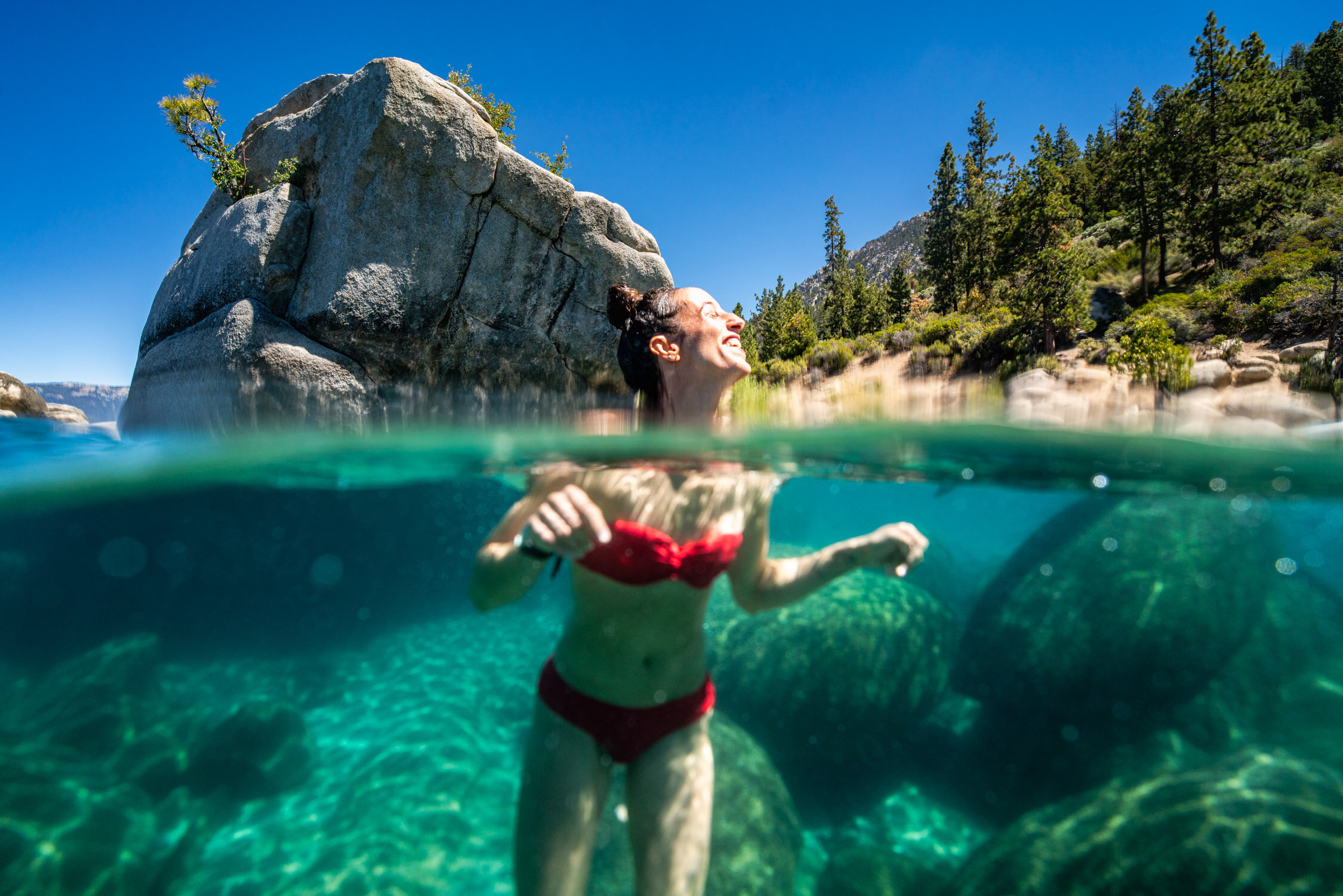
Lake Tahoe's legendary clear waters call to swimmers with a promise of refreshment unlike anywhere else. Sand Harbor on the Nevada side rewards visitors with smooth sandy beaches, crystal-clear shallows, and dramatic granite boulders that rise from the water. The gradual entry and gentle shoreline make this spot particularly welcoming for families with young children.
For those willing to venture further, Emerald Bay delivers on its name with waters that shift between deep jade and sapphire blue. Nestled on Tahoe's west shore beneath the historic Vikingsholm castle, swimming here puts you at the heart of some of the lake's most dramatic scenery. The water runs cooler than other beaches, but floating on your back surrounded by forested mountains creates memories worth the slight chill.
Trails that reveal lake views at every turn

The trails surrounding Lake Tahoe offer hikers that rare combination of accessibility and wild beauty. The Tahoe Rim Trail circles the entire basin with 170 miles of paths that range from gentle forest walks to challenging mountain traverses. Even tackling small sections rewards you with sweeping views across the cobalt blue lake to snow-capped peaks beyond.
Eagle Falls Trail packs remarkable scenery into a manageable 2-mile round-trip route. This moderately challenging path climbs past cascading waterfalls with several natural viewpoints overlooking Emerald Bay from above. Spring hikers catch the falls at their thunderous peak when snowmelt feeds the streams.
Families and casual walkers find Spooner Lake Trail perfectly suited for an easy nature immersion. This 2.5-mile loop winds through aspens and pines circling the small alpine lake. The relatively flat terrain makes this an ideal spot for multigenerational hikes or those days when you want nature without exhaustion.
Paddle your way to peaceful waters

Gliding across Lake Tahoe's surface by kayak or paddleboard offers perhaps the most intimate way to experience its clarity. D.L. Bliss State Park on the west shore provides calm, protected waters and stunning granite cliff backdrops. The park includes convenient launch points and rental options for those traveling without their own craft.
The Upper Truckee River presents paddlers with a different kind of Tahoe experience. This meandering waterway that feeds the lake passes through meadows bright with wildflowers and forests rich with birdsong. Depending on the season and water levels, paddlers can find stretches suitable for peaceful floating or more engaging currents.
First-timers might consider connecting with Tahoe City Kayak, whose guided tours combine paddling instruction with insights about the watershed's ecology and history. Their morning tours often catch the lake at its calmest, when the water surface turns to glass and visibility extends dozens of feet below your boat.
Hidden corners away from the crowds
Even in peak season, Lake Tahoe still harbors quiet spaces for those willing to seek them. Meeks Bay on the west shore often gets overlooked by visitors heading to more famous beaches. Its crescent of sand, backed by tall pines and framed by mountain views, offers a peaceful alternative to busier shores, especially on weekday mornings.
Chimney Beach earns its solitude through a short but steep trail descent to the eastern shoreline. Named for the stone chimney that stands as the last remnant of an old cabin, this pocket of sand and smooth stones attracts visitors seeking quiet contemplation rather than bustling beach scenes.

For true wilderness immersion, the Desolation Wilderness beckons just beyond Tahoe's western edge. This rugged landscape of granite peaks, alpine meadows and crystal lakes offers day hikers and backpackers alike a chance to experience the Sierra Nevada in its most pristine form. Access through the Echo Lakes Trailhead requires planning ahead for permits if staying overnight, but rewards with star-filled skies and profound quiet.
Through these outdoor adventures, Lake Tahoe reveals itself not just as a destination, but as a living landscape that changes with seasons, weather and time of day. Whether you're floating in its clear waters or hiking its forested shores, Tahoe offers countless ways to reconnect with the natural world—and yourself.
When to visit Lake Tahoe
Timing your visit to Lake Tahoe can shape your entire experience of this magnificent lake. Each season here unfolds with its own rhythm and gifts. Here's what to expect throughout the year to help you plan a visit that matches what you're seeking.
Each season's quiet magic
Lake Tahoe transforms with the seasons, each bringing a distinct mood to these mountain-cradled shores.
Spring wakes up the landscape as snowmelt feeds waterfalls and reveals hidden trails. Wildflowers begin their colorful display while crowds remain thin. The lake sits higher this time of year, creating perfect conditions for paddling adventures. Wildlife becomes more visible too—deer emerging from winter hideaways, birds returning to the shoreline. Morning mist often hangs over the water, creating ethereal moments for early risers.
Summer brings the classic Tahoe experience many travelers seek. Sun-warmed days stretch long, perfect for swimming in that legendary clear water or lounging on golden beaches. Hiking paths offer cool forest shade leading to spectacular overlooks. While summer draws the biggest crowds (especially weekends), early mornings and weekdays offer pockets of tranquility. The water temperature remains refreshingly cool even in August—a perfect balance to hot afternoons.
Fall paints Tahoe with amber and gold as aspen groves change color against the evergreen backdrop. Hope Valley, just south of the lake, puts on a particularly stunning show. Temperatures cool and hiking becomes especially pleasant without summer's heat. Photographers find magic in the clear autumn light playing across the water. Fish become more active in the cooling waters, rewarding patient anglers.
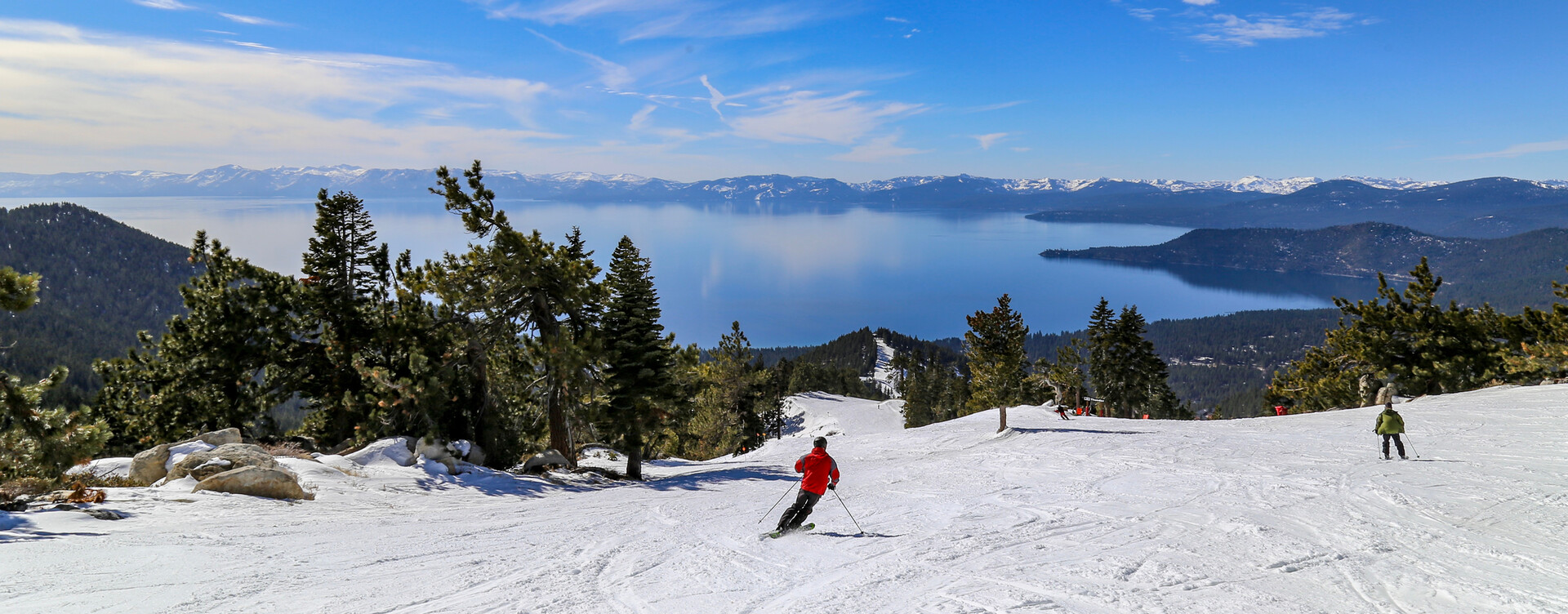
Winter transforms Tahoe into a snow globe world of white-dusted pines and frozen shorelines. The surrounding mountains become playgrounds for snow sports, with pristine powder drawing winter enthusiasts from across the country. Beyond the slopes, snowshoe trails and cross-country paths reveal the quiet beauty of snow-draped forests. The contrast between deep blue water and snow-covered shores creates a visual feast found nowhere else.
Exploring with intention and care
The magic of Lake Tahoe lies as much in its wild spirit as in our collective promise to protect it. Let's talk about how we can all tread lightly while still soaking in those unforgettable lake moments.
Leave No Trace in practice
Leave No Trace isn't just a catchy phrase—it's how we show respect for the places that give us so much. At Lake Tahoe, these principles become especially important where crystal waters meet fragile shorelines.
Before hitting the trail, do a little homework. Know which areas require permits, where dogs can roam, and current fire restrictions. Pack a small trash bag for carrying out everything you bring in—yes, even apple cores and pistachio shells. Those "natural" bits don't belong here either.
Traveling thoughtfully in wild spaces
Being a mindful visitor at Tahoe means considering how our choices ripple through both ecosystems and communities.
When you're hungry after a long paddle, seek out the family-run cafes and shops that operate year-round, not just during tourist seasons. Many local businesses take extraordinary measures to reduce waste and source ingredients sustainably.
Water conservation matters deeply here. Quick showers, turning off taps, and being mindful of what goes down drains all help maintain the lake's remarkable clarity that draws us here in the first place.
Some practical tips we've gathered from local guides:
Carry a collapsible water bottle that takes up minimal pack space when empty
Choose mineral-based sunscreens that won't harm aquatic life
Photograph trailhead maps instead of taking paper maps
Follow parking regulations—even if it means walking a bit further to reach popular spots
By exploring mindfully, you'll discover that taking care of Tahoe deepens your connection to this extraordinary place.
Where to rest and recharge
After a day of exploring Lake Tahoe's natural wonders, you'll need a place to rest and recharge. Whether you prefer camping under the stars, van life adventures, or eco-friendly lodging, Lake Tahoe offers a variety of accommodations that respect the land and support mindful travel.
Campsites and spots for van life

Lake Tahoe is a camper's paradise, with numerous campsites that put you right at nature's doorstep. D.L. Bliss State Park on the west shore offers tent and RV camping with basic amenities like restrooms and showers. These sites sit tucked among tall pines with easy walks to the lake and trailheads.
For those seeking more solitude, Desolation Wilderness delivers a true backcountry experience (permit required). Access this stunning landscape via the Echo Lakes Trailhead to find quiet camping spots far from crowds. Just remember your Leave No Trace ethics—pack it in, pack it out.
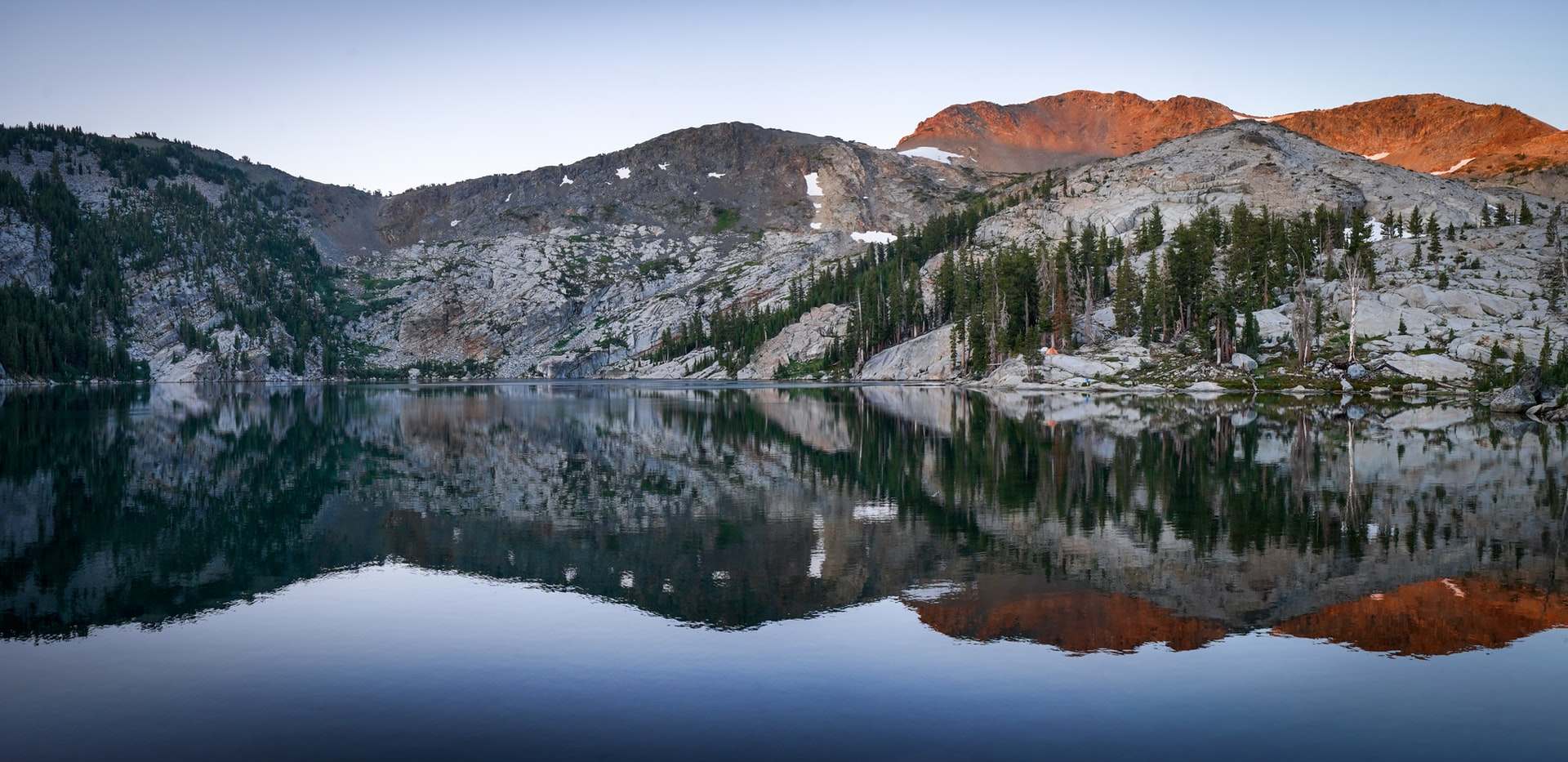
Van life travelers will find plenty of sweet spots throughout the Tahoe National Forest, which allows dispersed camping in designated areas. You can wake up to pine-scented mornings and star-filled nights, but check local regulations first—rules change seasonally to protect this fragile ecosystem.
Staying somewhere that cares about the land
If you crave more creature comforts, several Lake Tahoe lodgings put sustainability front and center. Edgewood Tahoe in South Lake Tahoe backs up its environmental commitment with a LEED-certified lodge that minimizes energy use while maximizing comfort. Their conservation efforts extend beyond the building to protecting the watershed and supporting local initiatives.
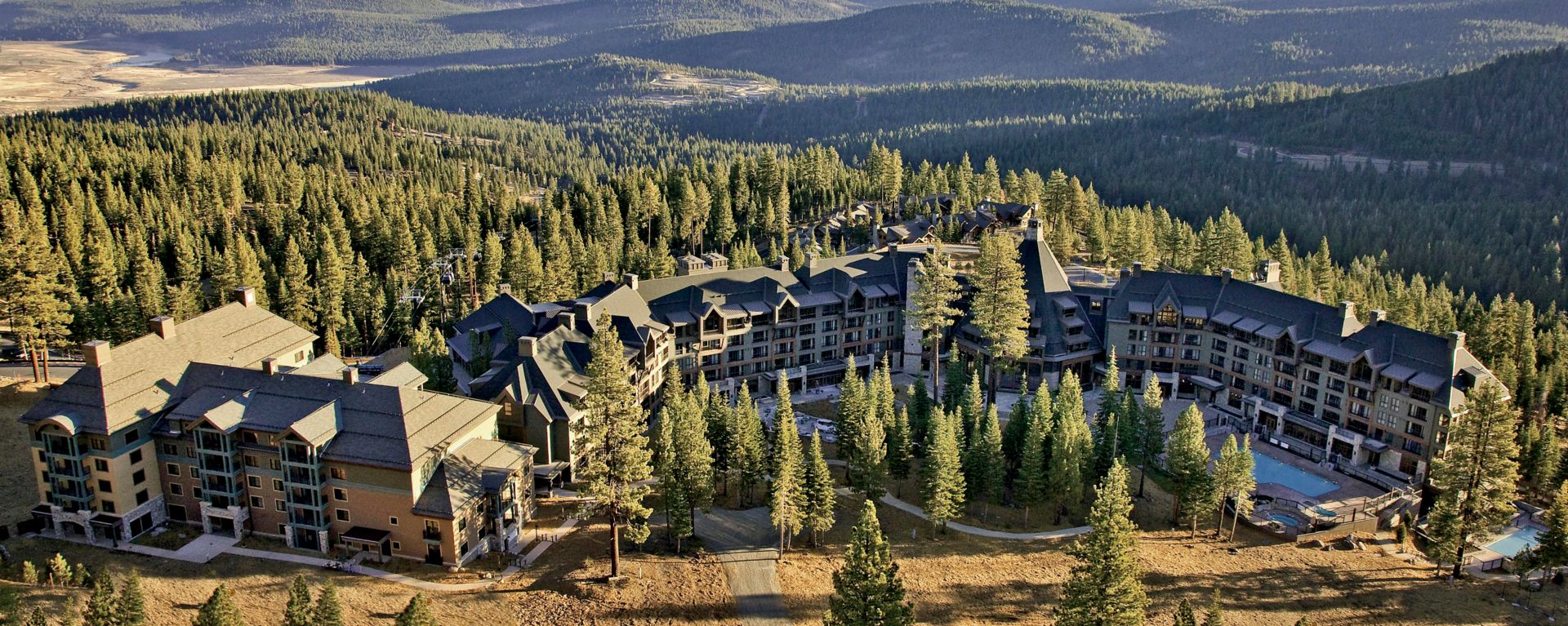
The Ritz-Carlton, Lake Tahoe at Northstar combines comfortable stays with conservation through water-saving fixtures, energy-efficient systems, and locally sourced dining options. The property offers direct access to seasonal activities without unnecessary environmental impact.
For something cozier, the Cedar House Sport Hotel in Truckee reflects the area's natural beauty while treading lightly on the land. This thoughtful boutique hotel runs on solar power when possible, uses efficient appliances, and incorporates materials from the region. Their guided adventures help guests connect meaningfully with Tahoe's wild places.
No matter how you choose to rest here, you'll find options that let you recharge while honoring the natural beauty that makes Lake Tahoe worth protecting in the first place.
Conclusion: Follow your curiosity to Lake Tahoe's wild edges
Lake Tahoe isn't just another spot on a map—it's a living, breathing invitation to slow down and pay attention. Those crystal-clear waters and quiet mountain corners ask you to trade scrolling for swimming, and schedules for spontaneous trail discoveries.
There's something deeply personal waiting for you here, whether it's the perfect rock for morning meditation by Emerald Bay, a section of the Tahoe Rim Trail where the lake suddenly appears through the pines, or a hidden cove you discover while paddling away from marina traffic.
This is a place that rewards the curious and the unhurried. So fill your water bottle, toss a journal in your backpack, and let the wild edges of Tahoe guide you. The lake has been waiting—not just for visitors, but for people who want to really see it.
Frequently Asked Questions
What makes Lake Tahoe so remarkable?
The best time to visit Lake Tahoe depends on your interests. For winter experiences, the months of December to February are ideal. For those interested in beaches and water sports, summer months from June to August offer warm weather and clear skies. Spring and fall provide milder climates, perfect for hiking and exploring the region. Regardless of when you visit, Lake Tahoe's natural beauty and diverse activities ensure a memorable experience.
Does Lake Tahoe sit in Nevada or California?
Lake Tahoe claims both California and Nevada as home, with the state line running right through its deep blue waters. This dual-state personality shapes the different experiences you'll find around its shores.
When's the most rewarding time to visit Lake Tahoe?
Every season at Lake Tahoe offers its own quiet magic, rewarding visitors who tune into its natural rhythms.
Is swimming still possible in Lake Tahoe?
Swimming in Lake Tahoe isn't just possible—it's one of the most soul-stirring experiences the lake offers. Floating in water so clear you can watch your shadow on the lake bottom 20 feet below creates moments that stay with you long after you dry off.

